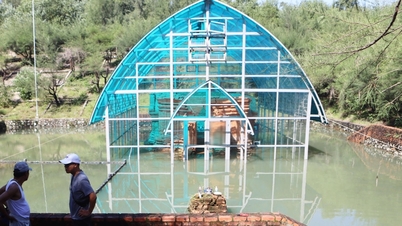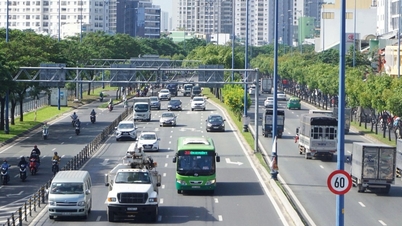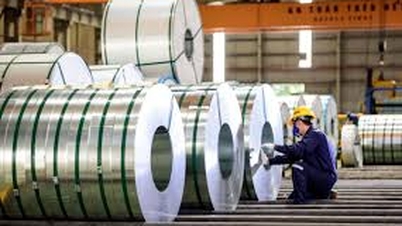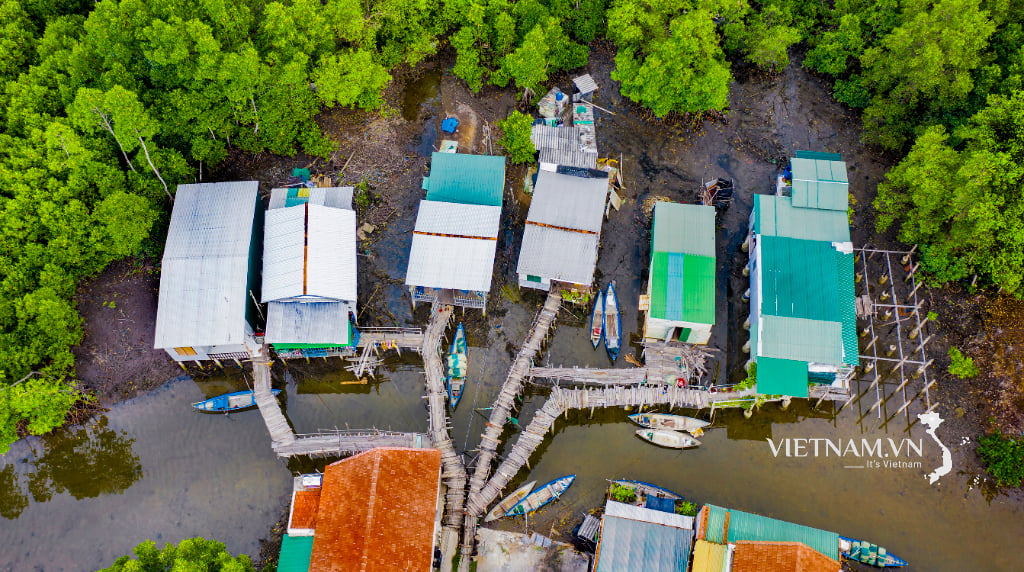According to Dan Tri reporter's records, up to now, the management unit of the Phu Dien Cham tower relic, located in Phu Vinh commune, Hue city, still maintains a pump to drain water out of the relic.
Phu Dien Tower is considered by researchers to be a special case, of great historical and cultural value and a model for studying the architecture of Cham temples and towers in the early stages. Prolonged flooding can be dangerous, affecting the longevity of the structure.

Mr. Nguyen Truong, guard of Phu Dien tower, turned on the water pump to prevent flooding of the relic (Photo: Vi Thao).
Mr. Nguyen Truong, the relic site's security guard, said that the huge amount of water that caused severe flooding to the structure more than a week ago has been pumped out. However, seawater continues to leak in, causing continuous flooding at a lower level.
According to Mr. Truong, in the past, the Phu Dien Cham tower was also flooded when there was heavy rain, but it only dried up after 2-3 days. This is the first time this situation has lasted so long and continuously.
Mr. Truong was assigned to regularly check, when detecting rising water, every 3 hours he had to start the engine to pump the water out.
As a local resident, Mr. Truong believes that the reason for the relic being continuously flooded is because the current high tide is quite extreme, rising for a long time. In addition, the coastline of Phu Dien tower area has been severely eroded, making it easier for water to erode.

The coastline of Phu Dien tower area is increasingly eroded, affecting constructions and residential areas (Photo: Vi Thao).
As Dan Tri reported, due to the impact of the recent heavy rain, the Cham tower relic Phu Dien, Phu Vinh commune, was flooded for a long time.
Mr. Hoang Hai Minh, Vice Chairman of Hue City People's Committee, severely criticized the management unit and local government for the slow implementation of the treatment plan.
According to the Hue City History Museum, the above-mentioned ancient Cham tower was discovered in April 2001. When it was first discovered, the tower was located 5-7m deep under the sand dunes, 3-4m below sea level and 120m from the water's edge.
After the discovery, the authorities built a protection area for the relic with solid concrete blocks. The ancient tower was also preserved in a greenhouse to limit the impact from the natural environment.

The more than one thousand year old Cham tower was once severely flooded (Photo: Vi Thao).
At the end of 2001, the Ministry of Culture, Sports and Tourism decided to rank Phu Dien tower as a National Architectural and Artistic Monument.
In 2022, the Vietnam Record Organization established the record "Phu Dien Tower - the first ancient Cham tower sunk deep under a coastal sand dune excavated and preserved in Vietnam". In the same year, the World Record Union continued to recognize the record "The first ancient brick Cham tower sunk deep under a coastal sand dune excavated and preserved in the world".
In a scientific document, Dr. Nguyen Van Quang, Deputy Head of the History Department, University of Sciences, Hue University, described that Phu Dien tower is so far the only temple-tower structure of Champa discovered to be built right on the coast.
Because it is located in a sand dune area, the geological structure is weak, and is often affected by the phenomenon of displacement. In addition to treating the tower foundation with sand, gravel, and compacted clay, on the sea side, the ancients also built a solid surrounding wall. The embankment was driven with wooden piles deep into the sand, and covered with solid clay, which has the ability to prevent subsidence for the architecture and prevent erosion by sea waves.
Source: https://dantri.com.vn/du-lich/thap-cham-nghin-nam-tuoi-di-tich-dac-biet-chua-het-ngap-nuoc-20251114152055889.htm


![[Photo] Unique architecture of the deepest metro station in France](https://vphoto.vietnam.vn/thumb/1200x675/vietnam/resource/IMAGE/2025/11/14/1763107592365_ga-sau-nhat-nuoc-phap-duy-1-6403-jpg.webp)


![[Photo] Unique art of painting Tuong masks](https://vphoto.vietnam.vn/thumb/1200x675/vietnam/resource/IMAGE/2025/11/14/1763094089301_ndo_br_1-jpg.webp)






























![[Photo] Special class in Tra Linh](https://vphoto.vietnam.vn/thumb/1200x675/vietnam/resource/IMAGE/2025/11/14/1763078485441_ndo_br_lop-hoc-7-jpg.webp)







































































Comment (0)